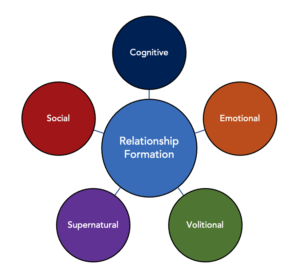When it comes to the biblical directive to love immigrants, Canada is a land teeming with opportunity. According to 2021 Statistics Canada data, 23.0% of Canadians are foreign born (landed immigrants and permanent residents).[1] In 2023 Canada welcomed more than 471,000 new permanent residents.[2] In addition, that year alone there were more than 183,000 temporary foreign workers in Canada,[3] about 51,000 new refugee claimants,[4] and more than 900,000 international students.[5] What can our churches do to help those who are new to Canada move along a pathway to Jesus?
Love New Canadians. A 3-Stage Intercultural Ministry Pathway
At our church in Calgary we have created a ministry for immigrants that consists of three parts. This pathway is a strategy for intercultural ministry. Stage 1 consists of classes and events that help newcomers settle in Canada. These classes have little or no spiritual content. Stage 2 is a transition from Stage-1 to Stage-3 classes. It is a gentle introduction to the Gospel for those who are curious about Jesus, Christianity, or the Church. Stage 3 consists of classes for those who want to follow Jesus or who are looking closely at what it would mean to follow Jesus. It consists of ESL Bible studies, Alpha, worship services, and small groups.
Stage 1: Friendship
Our goal with the Stage-1 classes is to meet the needs of immigrants in our neighbourhood and to help them settle into life here. We provide services that result in people in our neighbourhood coming into our church building and getting to know Christians who show love to them. Stage 1 consists of various ESL classes, “Jobtalk,” a citizenship class, the “Immigrant Transitions” class, novel studies, and “Project Confidence” (a public speaking class). A key part of Stage-1 activities is our monthly parties. They are a great way for us to get to know each other in a relaxed atmosphere. Examples include farm trips, garden tours, camping, curling, hiking, street hockey (or, in our case, church–parking lot hockey), snowshoeing, skating, mini-golf, an Easter egg hunt, banquets, and potlucks.
People come to these classes and events because they want to learn, to find a job, or to make friends. Some attend because they are bored, or lonely, or perhaps just curious about what happens in the church building. Many people have told me that coming to one of our classes was the first time they had ever entered a church building. When our immigrant friends feel comfortable and when they find the activities helpful and enjoyable, they are very likely to come back, try other classes that we offer, and invite a friend.
In Leviticus 19, God said to the people of Israel through Moses: “The foreigner living with you must be treated as one of your native-born. Love immigrants as you love yourselves. Remember, your people were also once immigrants. I am the LORD your God” (Lev 19:34). We begin with settlement programming as a way to treat immigrants like we would want to be treated if we moved to another country. We have discovered that this strategy is effective for producing spiritual conversations. We are comfortable spending weeks, months, and sometimes even years getting to know our immigrant friends as we trust the Spirit of God to draw them to Jesus.
Stage 2: Spiritual Curiosity
The second stage on the pathway is the transitional programming. We call it our ESL Bridges class. This class bridges the gap between settlement classes and events (Stage 1) and spiritual classes (Stage 3), focusing on the English language, Canadian culture, and the life and teaching of Jesus. It can be difficult for a newcomer to make the transition from an ESL class, farm trip, or line-dancing lesson to the spiritual conversations of a Bible study or Alpha. The Bridges class helps fill this gap.
We believe God gave us the idea for the Bridges class to address the spiritual curiosity of immigrants. Those who come are not usually interested in becoming followers of Jesus (at least not yet), but they are curious about our faith. Many come from countries where they were unable to ask questions about Jesus, the Bible, Christianity or the Church.
We begin each class with a focus on some aspect of culture. Every week it is something different. Examples include celebrating Thanksgiving, looking at the northern lights, dealing with a car accident, or finding a physician.
After the cultural introduction, we look at a lesson from the Gospels that is designed to help students learn English while exploring questions related to their own spiritual curiosity. Rather than trying to help students understand the Bible (which is a great goal), in this class we use the life and teaching of Jesus to generate discussion questions for newcomers to talk about their own lives. For example, when looking at John 2, where Jesus turns water into wine, we asked questions about marriage:
Q. In verse 2 Jesus and his followers were at a wedding. What are the components (parts) of a wedding in your birth country?
Q. What food is served at a wedding in your birth country?
Q. What are the various roles (jobs) people have at a wedding? Verse 10 refers to those who “have had too much to drink.” What are the effects of drinking too much?
Q. How would your life be different if you could change water into wine?
Each week we include a question that a seeker might ask to help us think about the personal implications of Jesus’ words:
Q. These verses in John tell us the story of Jesus’ first miracle. What miracle would you like Jesus to do for you?
We have found that these personal questions naturally lead to spiritual conversations. Newcomers learn English while at the same time building friendships with fellow students and loving Christian volunteers. These kinds of questions invite honesty and vulnerability. When we speak honestly ourselves and express our own vulnerability, our immigrant friends respond in a similar manner. Over time, we are able to have comfortable and natural spiritual conversations.

Stage 3: Spiritual Focus
The third stage of this pathway to Jesus consists of spiritual classes, like ESL Bible studies and Alpha. It is for those who want to follow Jesus, or are close to faith, or new to faith. This is the kind of teaching that Christian faith communities are good at, though sometimes they need help with the ESL component.
Our pathway is designed to make it easy for immigrants to move from Stage 1, to Stage 2, and then to Stage 3, where they become mature followers of Jesus. We have found that, on average, for every ten who attend settlement classes and events (Stage 1), four will attend the Stage-2 ESL Bridges class, and two will attend the Stage-3 spiritual classes. Our goal is to increase the settlement programming so that more people will be on the pathway to Jesus. The more new Canadians attending Stage-1 settlement classes, the more will come to the Stage-2 ESL Bridges class, and the more will attend Stage-3 Alpha classes and ESL Bible studies.
In the past seventeen years we have seen hundreds of our immigrant neighbours progress along a pathway towards Jesus, and dozens have become his disciples. Many join small groups, volunteer, bring their children to Sunday school classes, and attend worship services. Since we started Love New Canadians in 2014, we have found that the model also works well across Canada, in faith communities with as few as twenty-five people, large churches with more than five thousand members, and everything in between.
[1] https://www150.statcan.gc.ca/n1/daily-quotidien/221026/dq221026a-eng.htm accessed Jan 20, 2023.[2] https://www.cicnews.com/2024/02/canada-welcomed-471550-new-permanent-residents-in-2023-0242798.html#gs.d44amy accessed Aug 3, 2024. See also https://www.immigration.ca/canada-welcomes-record-471550-new-permanent-residents-in-2023/ accessed Aug 3, 2024.[3] https://www.hcamag.com/ca/specialization/immigration/temporary-foreign-worker-approvals-more-than-double-from-2018-to-2023-report/494668#:~:text=How%20many%20temporary%20residents%20are,reported%2C%20citing%20data%20from%20ESDC accessed Aug 3, 2024.[4] https://www.irb-cisr.gc.ca/en/statistics/protection/Pages/RPDStat2023.aspx accessed Aug 3, 2024.[5] Calgary Sun, Jan 14, 2024, p. 10 (no author stated).
 However, when we think about conversion (and evangelism), we tend to emphasize just one area of transformation. In fact, most of our ways of framing what it means to become Christian fall into one of five models of conversion:
However, when we think about conversion (and evangelism), we tend to emphasize just one area of transformation. In fact, most of our ways of framing what it means to become Christian fall into one of five models of conversion: